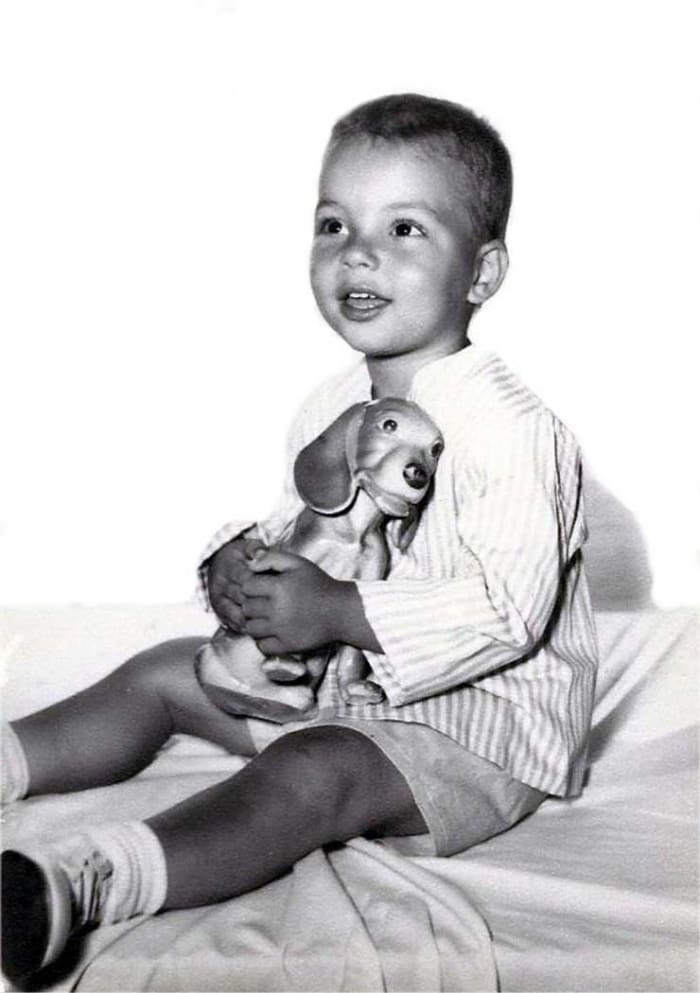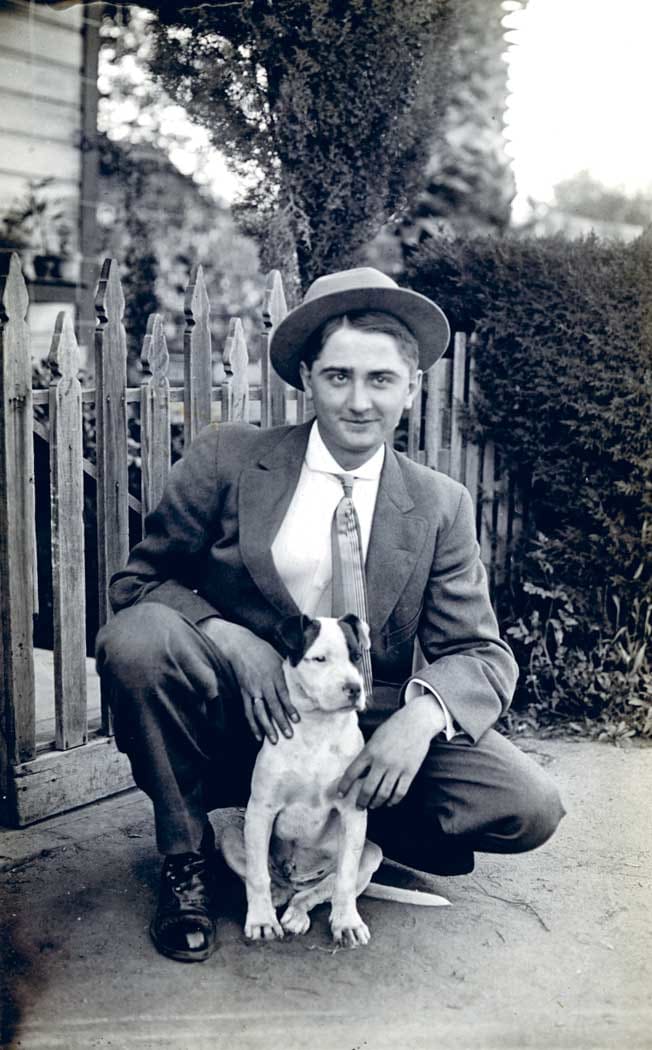
Love Immortal: Antique Photographs and Stories of Dogs and Their People.
Copyright ©2022 by Anthony Cavo. Reprinted courtesy of Harper Design, an imprint of HarperCollins Publishers.
An avid collector of nineteenth- and early twentieth-century photographs for more than fifty years, Anthony Cavo has amassed an enormous catalog of antique photography, including hundreds of shots of people and their dogs. These photos were taken from approximately 1840 to 1930 and offer a wide display of both candid and formal studio poses. They also form the foundation of his exceptionally warm, informative and delightful new book, Love Immortal: Antique Photographs and Stories of Dogs and Their People (Harper Design, $25.99).
If you recognize the name, it’s because Cavo, a certified appraiser of art and antiques, is a longtime contributor to Antique Trader. He comes by his passion for old stuff honestly.

Author Anthony Cavo’s love for dogs started early in life. Here he is at age two with his toy dog.
Courtesy Anthony Cavo
The son of an antique dealer, he began collecting nineteenth- and early twentieth-century photographs at the age of seven. As a kid he used to trawl neighborhoods in Brooklyn, Queens, and Manhattan with his red wagon, collecting antiques from the curb and selling them at a variety of flea markets, most notably, the 26th Street Flea Market in Manhattan. He used his profits to buy photographs and continued this pastime throughout grade school and high school, eventually becoming one of the youngest auctioneers at a New York City gallery.
We recently caught up with Cavo to discuss Love Immortal, antique photographs and the timeless bond between dogs and their people.
ANTIQUE TRADER: What is it about old photographs that grabbed your attention and wouldn’t let go?
ANTHONY CAVO: It was simply the instant connection that spanned time. The best example of this connection that I can offer is the first time I encountered a hand-colored, post-mortem Daguerreotype of a young girl. I purchased a box of mid-nineteenth century photos from two elderly sisters whose family had lived in the same sandstone house since the eighteenth-century. When I returned home and began to go through the images, I found this photograph. Initially, I was a bit stunned. I simply stared at this touching image and found myself imaging how many evenings this child’s parents sat in a candlelit room holding and staring at, maybe even caressing, this very photo. When you see such an image you can’t help but feel sympathy for people you’ve never met and once that happens, you’ve made a connection.

Alma and her collie, Psyche, Kansas, circa 1915. On the back of the photo is the following inscription: “What do you know about Psyche and me? She is a whole year old now, anda big dorgie [sic]. Write pretty soon, Alma.”
Copyright ©2022 by Anthony Cavo. Reprinted courtesy of Harper Design, an imprint of HarperCollins Publishers.
Unless and until actual time travel becomes possible, antique photographs are a readily available alternative. Historic melodramas and movies can be realistic, fascinating and informative, but ultimately, they are characters played by modern people wearing reproduced costumes. When you look at an antique image, you are in a sense transported back anywhere from 100 to 180years ago. You see actual people wearing what they actually wore. Careful examination of these images can uncover some interesting facts about the subject, especially if the image in an occupational. An occupational image is one where the person or people dress in a particular manner or hold an object that informs us of their occupation. Understanding what these people did to earn their living is also another connection.
AT: Out of all your thousands of images you’ve collected over the years, why do the images of dogs and their people resonate with you?
CAVO: There are almost 600 images of dogs and their people in my collection. When I bought each one, I did so because of the dog and especially prized those images that conveyed a dog’s personality. I especially valued images where the affection between a dog and human is apparent. Of all the categories of photos in my collection, I found this genre to be the most surprising. I had certain preconceived notions of how dogs were treated during the nineteenth-century and these photos completely changed those notions. I presumed dogs were valued for their ability to hunt, herd, haul, rescue, guard and protect. I imagined companionship was secondary and that dogs were treated only as well as was necessary to keep them performing.

Circa 1900s and inscribed to “Aunt Ida,” this image of a young boy and his dog is known as a real photo postcard, an early twentieth-century innovation that was as popular as selfies are today.
Copyright ©2022 by Anthony Cavo. Reprinted courtesy of Harper Design, an imprint of HarperCollins Publishers.
I was surprised to see just how loved these dogs actually were. To have a photograph taken during the mid-nineteenth century was usually an expensive and complicated process, especially if you did not live in a city. To travel to a photo studio and pay for a costly image of yourself with a dog dispels the idea that a dog’s love was not as important or even more important than the purpose a dog served. Victorians loved their dogs and brought them into the parlor whereas before they were relegated to kitchens, barns, farmyards, and fields.
AT: One wonderful thing about your book is how it illustrates just how timeless our love of dogs is. What a pleasant treat. Were you surprised by this early in your collecting?
CAVO: I was very surprised. As I mentioned, I assumed that nineteenth-century dogs were bred and kept for the work they were able to perform. I thought a dog’s companionship was not a consideration or a secondary consideration at best.

Charles, a sharp fellow, posed with his even sharper mixed breed terrier in Boulder, Colorado, 1881. Charle’s felt hat with ribbon band, three-piece suit, watch chain, clean-shaven face and handlebar mustache tell us he was quite fashionable.
Copyright ©2022 by Anthony Cavo. Reprinted courtesy of Harper Design, an imprint of HarperCollins Publishers.
AT: Your images are captivating. That’s to be expected in a picture book. But Love Immortal is more than a picture book. Your writing reflects a respect, love and a playfulness that every dog lover can appreciate. Why was it so important for you to inform as well as entertain?
CAVO: I find that with anything, including all types of antiques, that a person’s appreciation of an item usually increases dramatically when they learn something interesting about a particular item as compared to simply seeing it.
AT: It’s impossible, we get it, but we must ask: Do you have a favorite photo in the book?
CAVO: When I look at these photos, I can appreciate each one for different reasons. There are a couple of photos that captivate me because of the inability to separate the subjects from the contrasting light and shadow. These images are an inseparable amalgam rather than a sum of all their discernible components; the dog, person, and contrasting light and shadows are indissolubly blended.
The photos displaying joyful expressions of children posing with their dogs are some of my favorites. I especially love the photo on page 204 of the young boy and dog from Minnesota where the dog is staring directly into the camera with an expression that can only be described as a combination of surprise and curiosity.
From a photographer’s perspective, the photos on pages 133 and 136 are the type of photograph I would be very proud to have taken. One is an image of two women in deep black clothing looking off to the side while the pure white shepherd sandwiched between them looks directly into the camera; it is clear he is the star.

Christmas photo taken of two Danish women and their mesmerizing white shepherd, circa 1900, is one of the author’s favorites.
Copyright ©2022 by Anthony Cavo. Reprinted courtesy of Harper Design, an imprint of HarperCollins Publishers.
If I had to choose one photograph that summed up the essence of the book, it would be the image on page 109, “The Look of Love,” in which the dog’s adoration of his person is unmistakable and quite poignant; it is truly the look of love.
AT: Tell us about your first dog; and your current one(s).
CAVO: My first dog was named Silver, she was a white German shepherd, and although I was three years old when we lost her, I remember her well. After Silver, came Dolly, a sheltie. Dolly existed to give love. One day, a male dog jumped our fence and a little more than two months later, Dolly gave birth to ten puppies. My mother, a nurse, involved me and my siblings in the birth. The puppies came so quickly that most of them were still in their amniotic sacs. My mom showed us how to open the sac, suction the pups and even had us performing artificial respiration on a couple that were initially not breathing. This experience was memorable, magical, profound, largely responsible for the love my siblings and I have always had for animals. Everyone in our neighborhood knew that if they encountered an injured or homeless animal of any type, that our house was to place to bring them.

The author, when he wore a younger man’s clothes, with Schatzi, a standard black Schnauzer.
Courtesy Anthony Cavo
Currently, I am so busy that at times I used my house to bathe and sleep. To have a dog would be unfair. Fortunately, I live in a two-family house with my brother’s family and Buddy, a Labradoodle. The door between our houses is rarely closed, and when it is, Buddy knows how to open it. Buddy always greets me when I return home. He sits in the window, watches me park the car and then runs to my door to wait for me. Walking in that door and sitting on the steps with Buddy is usually enough to smooth the ripples of the day.
He doesn’t rest until everyone is home. During the night, Buddy does a nightwatchman’s rounds. He goes from bedroom to bedroom throughout the night to make sure everyone is present.
The others dogs in my life are my sister’s Yorkipoos, Vladimir and Sasha, and schnauzer, Otto.
I am also blessed with Maui, my best friend’s dog, who, of all the dogs in my life is my soul mate. I get to see Maui almost every day and when we are together, we are inseparable. When our eyes connect, I swear I can almost see his soul and it seems he can see mine.

This young California man who wore his hat nonchalantly on the crown of his head in 1910 posed proudly with his mixed breed terrier and boxer, seemingly unaware that the moment was fleeting. Thankfully, the occasion was captured by an amateur photographer.
Copyright ©2022 by Anthony Cavo. Reprinted courtesy of Harper Design, an imprint of HarperCollins Publishers.
AT: Favorite dog names?
CAVO: I once had a puppy called Dumpsy, but some of the dog names in Love Immortal are definitely unique. Pedro, Sancho, and Psyche are some of them.
When I lived in Dominica, I had a dog named Black-eye – I loved that dog; I still love that dog. I found Black-eye in the street, pretty much starved and so full of ticks that she appeared spotted. I bathed her and fed her and soon she was quite healthy, although she still had a yearning to run the streets. Very often, while traveling to Princess Margaret Hospital, I would have to stop the transport and get off because Black-eye would be running behind. Although she loved to run free, I had to keep her locked in the house.
At times, while I was at the hospital, Black-eye would get loose and actually find her way to the hospital ten miles away. More than a few times I heard one of the nurses say, “Your dog is here again.”
It wasn’t long before Black-eye had a litter of her own and shortly thereafter, she and her five pups were stolen from my house while I was on duty at the hospital; I never saw them again and I’ve never gotten over it.

Stella and her pup, Chief, enjoy an afternoon on the porch, circa 1890s.
Copyright ©2022 by Anthony Cavo. Reprinted courtesy of Harper Design, an imprint of HarperCollins Publishers.
AT: For you, what’s the best thing about having a dog in your life?
CAVO: The greeting I get when I open the door, the feeling of them pressed against me when we sit together, the adoring stares, the antics, and the simple, basic need we have for each other.
AT: Best advice for someone interested in collecting old photographs?
CAVO: Read, read, read. There are many informative books on antique photographs, but the three I recommend that are invaluable in dating and identifying antique photos are: Collector’s Guide to Early Photographs by O. Henry Mace, American Victorian Costume in Photographs by Priscilla Harris Dalrymple, and Dressed for the Photographer, Ordinary Americans & Fashion, 1840 – 1900 by Joan Severa.
If you are interested in collecting cased photographs (photos housed in cases made of thermoplastic, leather, pressed paper and even papier-mâché) then Nineteenth Century Photographic Cases and Wall Frames by Paul K. Berg is a must.
You may want to review the photograph articles in the Antique Trader; they offer a great deal of information is a very concise manner.

Taken approximately 115 years ago, the sweet image of a young Romanian woman and her dog speaks to their timeless bond.
Copyright ©2022 by Anthony Cavo. Reprinted courtesy of Harper Design, an imprint of HarperCollins Publishers.
AT: What do you hope people take away with them after reading your book?
CAVO: Aside from learning a great deal about the history of dogs, the pleasure of seeing them with their people, the laughs I hope they experience with the captions and the hours of pleasure they realize whenever they open the book, I would especially like them to appreciate that the love we have for our dogs transcends time, borders, religion and politics and that no matter how we as people differ, we at least have that one beautiful characteristic in common and as such, we understand each other at least on one level.
All images are from the book: LOVE IMMORTAL by Anthony Cavo. Copyright
©2022 by Anthony Cavo. Reprinted courtesy of Harper Design, an imprint of HarperCollins Publishers.









